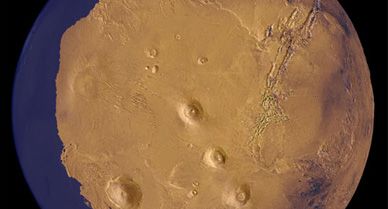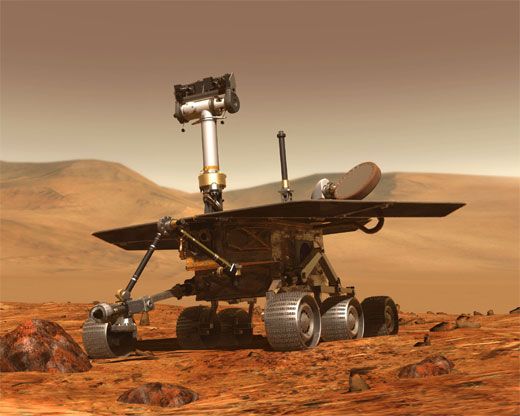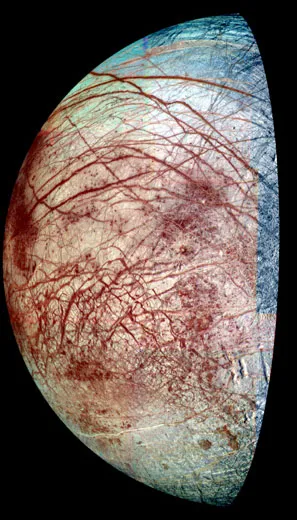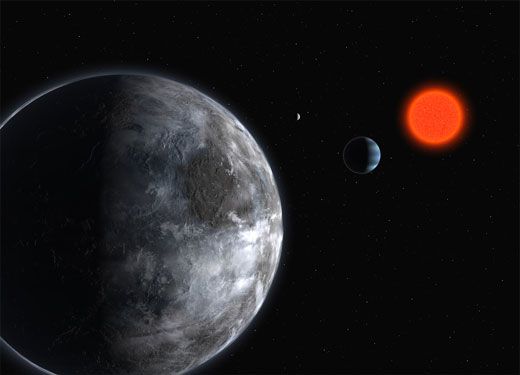Life Beyond Earth
An ocean on Mars. An Earth-like planet light years away. The evidence is mounting, but are astronomers ready to say we’re not alone?
/https://tf-cmsv2-smithsonianmag-media.s3.amazonaws.com/filer/life_rover.jpg)
"When I was a kid," says John Grant, "the big thing was: there are billions of stars in our own Milky Way, what are the odds that life doesn't exist?"
Grant, no longer a kid in stature if still in spirit, now plays a substantial role in setting those odds. The geologist at the Center for Earth and Planetary Studies, part of the National Air and Space Museum, is one of a half dozen scientists in charge of creating itineraries for Spirit and Opportunity, the two NASA rovers that since early 2004 have explored Mars for signs of life, past or present.
Researchers designed the rovers to gather images of rocks and terrain where water, the presumed prerequisite of life, might have flowed. Opportunity's success came soon after touching down at Meridiani Planum, Spirit's a while after landing among the volcanic rocks of Gusev Crater. But the rovers' life-detection skills are limited. They lack the equipment to analyze organic compounds or examine fossils. (The mission's running joke, says Grant, is that a rover will spot a dinosaur bone and be unable to retrieve it.) These tasks are reserved for the Mars Science Laboratory mission, scheduled for 2010.
The search for life in the universe, however, isn't confined to the rovers' path. For that matter, it's no longer limited to Mars, or even the Earth's solar system. More and more, astronomers at labs and observatories around the world are finding evidence for the foundations of life—foremost, water—in our planet cluster and beyond.
"As we get more data about places outside of Earth, we're starting to see conditions where you've got to scratch your head and say, 'This is a potentially habitable environment,'" says Grant. "It's not proof, but you're doing the statistics and they're all going in the category of: In Favor of Life."
That column received another check in mid June, when a group of scientists revived the idea that a vast ocean once existed on the northern hemisphere of Mars. A couple decades ago, scientists analyzed images of this region and found what seemed to be a shoreline. But an ocean shoreline has a uniform elevation, and later topographical tests revealed great variation—in some places, more than a mile separated the terrain's peaks and dips.
The new research, published in the June 14 Nature, argues that, in the past billion or so years, Mars has changed the way it spins on its axis. In the process, much of the planet's mass has shifted in a manner that accounts for the alternation of the once-level shoreline.
The ocean, of course, no longer ebbs and flows along this boundary. But it's unlikely that all the water escaped into the universe, says the study's lead author, J. Taylor Perron of Harvard University.
"We know that life, as we're familiar with it, seems to require liquid water," says Perron. "That basic requirement may have been satisfied on Mars, either when the ocean existed on the surface, or subsequently deeper within the crust."
Whether scientists can dig into the planet's surface and find evidence of water—and with it signatures of life—remains to be seen. Whether they can Massachusetts Institute of Technology, who was not associated with the study, in an accompanying commentary. "The result hints … that the understanding of the 'blue' history of the red planet is far from complete."
Many scientists believe that the blue history of Europa, one of Jupiter's moons, is still being written. Europa circles Jupiter every few days, and this rapid orbit generates friction that heats up the moon's interior. For that reason, some feel that an enormous salty ocean still exists beneath Europa's frozen surface, containing perhaps twice as much liquid as all the Earth's oceans combined.
Though the search for life on Mars has diverted attention and resources from Europa, the icy moon offers many indications that life could thrive there, including the presence of oxygen, hydrated salt and perhaps photosynthesis. Algae, bacteria and even animals exist in similar conditions in Antarctica, often living under ice shelves.
"If we made Europa a high priority and thought carefully about where to land, I think there's a good chance we'd find signs of life there," says planetary scientist Richard Greenberg of the University of Arizona. "If there was past life on Europa, I don't see why it wouldn't still be there. It's extremely active."
Because Europa is bombarded by radiation, Earth-like organisms could not live on the surface. But they might exist just several feet below in visible cracks. In recent papers and talks, Jere Lipps of the University of California, Berkeley, has outlined several ways in which life on Europa, or its remains, might be exposed to the surface—and likewise to rovers or orbiters sent to study the moon. These include places where ice has cracked and refrozen with life trapped inside; blocks of ice that have broken off, flipped over and now face the surface; and debris lodged in ridges or deep crevices.
Such exposures mean explorations to Europa could spot life without potentially difficult landing-and-digging missions. "Europa is active in the sense that its body is continually being reshaped," says Greenberg. "Ice is cracking, opening, closing. There's a good chance that oceanic substances regularly emerge to the surface."
While Europa and other sites near Earth, such as Saturn's moon Titan, remain promising places to find water, some scientists have set their sights far beyond this solar system. Recently, Travis Barman of Lowell Observatory in Flagstaff, Arizona, detected water in the atmosphere of a planet some 150 light years away—the first such evidence for a planet outside Earth's cluster.
The planet, known as HD 209458b, resides in the constellation Pegasus and is made entirely of gas. As seen from Earth, HD 209458b passes in front of its star every few days. During this stage, the planet's atmosphere blocks a certain amount of starlight, enabling Barman to model the atmospheric components. When he compared his models to images of HD 209458b from the Hubble telescope, those that included water in the atmosphere proved accurate, he reports in the June 1 Astrophysical Letters.
A couple weeks later, a team of European researchers announced another breakthrough outside this solar system: the discovery of a planet incredibly similar to Earth. The planet, some 20 light years away and five times the mass of Earth, circles the star Gliese 581. Several years ago, scientists found another planet—this one similar to Venus—orbiting this same star.
The new planet is much closer to Gliese than Earth is to the Sun, completing its orbit in about two weeks. But because Gliese is smaller than the Sun, the temperature on this planet's surface could be amenable to liquid water, the researchers report in an upcoming issue of Astronomy & Astrophysics. "The planet is the closest Earth twin to date," they write.
In the end, though, watery conditions, or even water itself, can only tell so much of the story of life beyond Earth. The conclusion must wait until more powerful tools or more precise explorations turn mere suggestion into solid proof.
"We believe that life, as we know it, needs water to exist, but the presence of water does not imply the existence of life," says Barman. "Without some direct evidence, it will be very hard to say if life, in one form or another, is present on any planet."
Smithsonian.com's reader forum
/https://tf-cmsv2-smithsonianmag-media.s3.amazonaws.com/accounts/headshot/eric-jaffe-240.jpg)






/https://tf-cmsv2-smithsonianmag-media.s3.amazonaws.com/accounts/headshot/eric-jaffe-240.jpg)